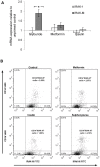Sulphonylurea usage in melioidosis is associated with severe disease and suppressed immune response
- PMID: 24762472
- PMCID: PMC3998927
- DOI: 10.1371/journal.pntd.0002795
Sulphonylurea usage in melioidosis is associated with severe disease and suppressed immune response
Abstract
Background: Melioidosis is a problem in the developing tropical regions of Southeast Asia and Northern Australia where the the Gram negative saprophytic bacillus Burkholderia pseudomallei is endemic with the risk of fulminant septicaemia. While diabetes mellitus is a well-established risk factor for melioidiosis, little is known if specific hypoglycemic agents may differentially influence the susceptibility and clinical course of infection with B. pseudomallei (Bp).
Methodology/principal findings: In this cohort study, patients with pre-existing diabetes and melioidosis were retrospectively studied.
Outcome measures: mortality, length of stay and development of complications (namely hypotension, intubation, renal failure and septicaemia) were studied in relation to prior diabetic treatment regimen. Peripheral blood mononuclear cells (PBMC) from diabetic patients and healthy PBMC primed with metformin, glyburide and insulin were stimulated with purified Bp antigens in vitro. Immune response and specific immune pathway mediators were studied to relate to the clinical findings mechanistically. Of 74 subjects, 44 (57.9%) had sulphonylurea-containing diabetic regimens. Patient receiving sulphonylureas had more severe septic complications (47.7% versus 16.7% p = 0.006), in particular, hypotension requiring intropes (p = 0.005). There was also a trend towards increased mortality in sulphonylurea-users (15.9% versus 3.3% p = 0.08). In-vitro, glyburide suppressed inflammatory cytokine production in a dose-dependent manner. An effect of the drug was the induction of IL-1R-associated kinase-M at the level of mRNA transcription.
Conclusion/significance: Sulphonylurea treatment results in suppression of host inflammatory response and may put patients at higher risk for adverse outcomes in melioidosis.
Conflict of interest statement
The authors have declared that no competing interests exist.
Figures




Similar articles
-
T-Cell Responses Are Associated with Survival in Acute Melioidosis Patients.PLoS Negl Trop Dis. 2015 Oct 23;9(10):e0004152. doi: 10.1371/journal.pntd.0004152. eCollection 2015 Oct. PLoS Negl Trop Dis. 2015. PMID: 26495852 Free PMC article.
-
Immunosuppression associated with interleukin-1R-associated-kinase-M upregulation predicts mortality in Gram-negative sepsis (melioidosis).Crit Care Med. 2009 Feb;37(2):569-76. doi: 10.1097/CCM.0b013e318194b1bf. Crit Care Med. 2009. PMID: 19114913
-
Overexpression of the endothelial protein C receptor is detrimental during pneumonia-derived gram-negative sepsis (Melioidosis).PLoS Negl Trop Dis. 2013 Jul 11;7(7):e2306. doi: 10.1371/journal.pntd.0002306. Print 2013. PLoS Negl Trop Dis. 2013. PMID: 23875041 Free PMC article.
-
Repaglinide : a pharmacoeconomic review of its use in type 2 diabetes mellitus.Pharmacoeconomics. 2004;22(6):389-411. doi: 10.2165/00019053-200422060-00005. Pharmacoeconomics. 2004. PMID: 15099124 Review.
-
Melioidosis: a clinical overview.Br Med Bull. 2011;99:125-39. doi: 10.1093/bmb/ldr007. Epub 2011 May 9. Br Med Bull. 2011. PMID: 21558159 Review.
Cited by
-
Modelling population dynamics and seasonal movement to assess and predict the burden of melioidosis.PLoS Negl Trop Dis. 2019 May 9;13(5):e0007380. doi: 10.1371/journal.pntd.0007380. eCollection 2019 May. PLoS Negl Trop Dis. 2019. PMID: 31071094 Free PMC article.
-
Mitigating the Impact of Antibacterial Drug Resistance through Host-Directed Therapies: Current Progress, Outlook, and Challenges.mBio. 2018 Jan 30;9(1):e01932-17. doi: 10.1128/mBio.01932-17. mBio. 2018. PMID: 29382729 Free PMC article. Review.
-
Melioidosis in Singapore: Clinical, Veterinary, and Environmental Perspectives.Trop Med Infect Dis. 2018 Mar 12;3(1):31. doi: 10.3390/tropicalmed3010031. Trop Med Infect Dis. 2018. PMID: 30274428 Free PMC article. Review.
-
Antidiabetic Drugs in the Treatment of Alzheimer's Disease.Int J Mol Sci. 2022 Apr 22;23(9):4641. doi: 10.3390/ijms23094641. Int J Mol Sci. 2022. PMID: 35563031 Free PMC article. Review.
-
Cell death and autophagy in tuberculosis.Semin Immunol. 2014 Dec;26(6):497-511. doi: 10.1016/j.smim.2014.10.001. Epub 2014 Oct 17. Semin Immunol. 2014. PMID: 25453227 Free PMC article. Review.
References
-
- Currie BJ, Fisher DA, Howard DM, Burrow JN, Lo D, et al. (2000) Endemic melioidosis in tropical northern Australia: a 10-year prospective study and review of the literature. Clin Infect Dis 31: 981–986. - PubMed
-
- Currie BJ, Dance DA, Cheng AC (2008) The global distribution of Burkholderia pseudomallei and melioidosis: an update. Trans R Soc Trop Med Hyg 102 Suppl 1: S1–4. - PubMed
Publication types
MeSH terms
Substances
LinkOut - more resources
Full Text Sources
Other Literature Sources
Medical

